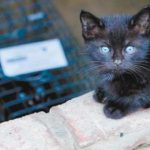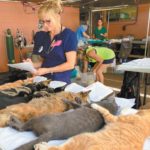Maui Humane Society ‘cat-apults’ young program addressing free-roaming felines
Deanna Nakamura wears a bright Day-Glo vest imprinted with the words “UHMC TNR Program Authorized Member” as she lugs a canister filled with kibble across the lower campus of University of Hawaii-Maui College.
She pauses near the community garden and begins calling her charges for dinner, much like a shepherd might call for his flock. “Kitty-kitty-kitty-kitty-Keee-teee,” she sings, lifting her voice almost an octave on the final “kitty.”
She repeats this mantra in a mesmerizing lilt as she gently shakes the kibble. A small black cat with blazing green eyes edges around the corner of a thick maiapilo bush, followed by a few more of his cautious brethren.
Then, as if on cue, a large, round and very furry tabby makes her presence known.
“That’s Grandma or Wide Load,” Nakamura introduces, explaining that the rotund, wizened cat is the matriarch of this particular colony on the UH-MC campus. “She has to be close to 20 years old.”
Nakamura has been tending to this and other cat colonies on the island for decades, and is now officially recognized as one of the campus’s colony caretakers thanks to a handful of influential UH-MC administrators who were open to working with Maui Humane Society.
“They were really helpful,” says UH-MC Vice Chancellor for Administrative Services David Tamanaha of MHS’s involvement with program implementation. In particular, Tamanaha cited the dedication of MHS Veterinary Clinic & community Cat Programs Manager Kelly Maguire.
“She is so knowledgeable, and it was her knowledge that helped us understand how this program works,” he says.
Tamanaha says Maguire spent weeks assisting in the night-time trapping of cats to help get the population to a manageable level as Trap-Neuter-Return program took hold.
Formally implementing the program at UH-MC has netted tremendous results in a relatively short time, notes Tamanaha, who was instrumental in getting the bulk of the administration on board — which was not always an easy sell, he recalls.
“There was a lot of debate about whether this would work,” Tamanaha remembers. But it already had worked — once. About 15 or 17 years ago, he says, unsung (and unsanctioned) efforts at humane cat population management by then UH-MC HR Director Debbi Brown and Nakamura resulted in a drop over time of 200 cats to about 30.
But a few years ago, after Brown left the university system for another position, the cat population began spiking again.
“It wasn’t something Deanna [Nakamura] could take on alone,” Tamanaha says.
He promised his less-than-supportive colleagues that they could revisit the issue in six months if things didn’t work out.
“We haven’t had to talk about it since,” Tamanaha says with a grin.
The colony population is back to a manageable number with help from security personnel who, along with Nakamura, are the only ones authorized — hence the day-glo vests — to feed the cats at eight designated feeding stations on campus.
UH-Maui College is only one of many success stories since MHS launched its community cats programs less than a year ago. Several golf and leisure resorts and a handful of large companies are looking at TNR programs as the best solution to control the loose-cat population.
And that is all due to educating the community about what works and what doesn’t, backed up by data and studies.
“For decades, Maui Humane Society has been accepting community cats,” explains MHS CEO Jerleen Bryant. “If they weren’t friendly and couldn’t be put up for adoption, they were immediately euthanized. But that strategy hasn’t decreased the number of cats roaming free on the island.”
The core of the TNR program — the first humane society-implemented program in the state–is returning healthy, sterilized cats that have been microchipped and vaccinated back to their territories.
“We’re not increasing the population,” Bryant is quick to point out. “That’s very important for people to understand.”
One of the greatest myths about the TNR or return-to-field programs is that cats are being added to the community, she says.
“Absolutely not,” Bryant stresses emphatically. “We’re putting a Herculean effort toward decreasing the number of cats in the community.”
Whether someone brings in a trapped cat because they’re worried about the safety of the animal or just consider it a nuisance, MHS staff educates that community member about the behaviors of free-roaming cats.
“If you think this cat is a nuisance, and you’re bringing it in because you don’t want it around, we try to help you understand that not returning the cat creates a void, and it won’t be long before another cat fills that spot,” Bryant explains.
“Cats are territorial,” she continues. “So if this is the only cat you’re seeing, there’s a reason; it’s keeping the other cats away — especially if you’re feeding it.”
Another way MHS hopes to inform the community about the benefit of TNR programs is through a public awareness campaign kicking off with an educational mailer that will be distributed in the coming weeks. The front of the mailer displays an ear-tipped cat with the statement “Leave this cat where it’s at!” and on the back, there’s a brief FAQ list about community cats and suggestions on how to become involved.
“Typically, people become involved in the program because they have a situation on their property, whether at home or their business or workplace,” says MHS cat trapper extraordinaire Kelly Maguire. “We encourage people to call us, because we can offer solutions dependent on their situation.
“When people do call in, we go case by case depending on what their needs are — whether complaints or management or population issues. Sometimes the solution is to offer traps so they can bring the animal in for free spay and neuter. Then we go over all the benefits of having those cats trapped, fixed and returned so they can continue to do their job of rodent control.”
It’s also important that the community understands that MHS has the funds to sterilize, microchip and vaccinate cats brought in through the TNR pathway, provided they are returned to their place of origin where they won’t breed while still keeping outside cats away from your home or property.
“Also, some of the behaviors you didn’t like, such as spraying or screeching in the middle of the night will drastically decrease because that cat is now sterilized,” Bryant advises.
Currently, MHS does not have the resources to go out and trap cats for the community.
“There are situations where we’ll come out and help trap, but it’s not typically a service that we can offer,” says Maguire. “I’ve done trapping for large businesses or for elderly or disabled people who physically cannot trap and bring the cat into us.
“I think the big misconception is that Maui Humane Society is responsible for ALL the cats on the island and all the problems that come with that,” Maguire continues. “It doesn’t really work that way. This is a team effort. We can come to you and offer this much, and you need to come and meet us halfway, because it truly is a community job. And when we do it that way, it works.”
Maguire, who has been dealing with the free-roaming cat population on Maui for 25 years, says without a doubt that TNR works.
“There will be some people who will be hard to convince that we’re not just ‘those crazy animal people over at the Humane Society who will do anything to save a cat,'” Bryant quips. “And while it’s true that we feel strongly about animals, we truly believe that community sterilization for cats is the only humane way to decrease the population.
“Basically, we want the same thing as those people who don’t like cats,” she concludes. “We want to see fewer cats in the community. And we really need that message to resound for the community support we need to make that happen.”
* Mona de Crinis can be reached at mdecrinis@mauinews.com.
- A kitten temporarily ignores the kitten-sized trap below. — Photo courtesy Maui Humane Society
- Trapped community cats await transportation to Maui Humane Society for neutering, microchipping and vaccinations before being released back to their original habitat. — Photo courtesy Maui Humane Society
- A cat colony caretaker checks on her charges at a Maui golf course. — Photo courtesy Maui Humane Society
- Sedated free-roaming cats are prepped for surgery at Maui Humane Society’s surgical center. — Photo courtesy Maui Humane Society
- If you’re interested in learning about MHS’s community cat programs or have questions about cats in your area, call 877- 3680, go online at www.maui humanesociety.org or visit the shelter’s campus Monday through Saturday from 11 a.m. to 6 p.m. at 1350 Mehameha Loop in Puunene. — Photo courtesy Maui Humane Society
- Two of the colony cats at UH-Maui College just before dinner time. — MONA DE CRINIS photo








